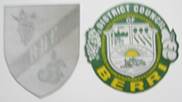Berri District
The name Berri comes from the Aboriginal description of "big river bend" on which the town has grown. Up until the 1870's the area was part of the Cobdogla sheep station and the home of the Erawirunga People. In those days it was just one of the hundreds of woodpiles along the huge Murray-Darling system, used by the riverboats for refueling. The town was proclaimed in 1911. The first irrigation blocks were allotted in 1911 and the first permanent settlers took up residence.
The District Council of Berri was declared on 26th July 1922, and the first meetings were held in private premises. The original Council Chambers were built in Strawbridge Street in 1924. Later, in 1979, a new Civic Centre (incorporating Offices, Library and Town Hall) was built in Wilson Street.
Until October 1996 the Berri Council comprised four Wards (two Town; two Rural), with each of the Town Wards having three Councillors on the Council, and the Rural Wards having two representatives each. The Chairman was originally chosen from among the elected Councillors, but in 1972 this practice changed, and a Mayor was elected as the eleventh member of the Council.
| The District Council of Berri Logo |  |
|---|
The functions of Local Government may be grouped broadly into two areas; firstly, works and services carried out to improve local land and property; and secondly, works and services which are of principal benefit to the community.
The first major project undertaken by the Council was to supply the District with electricity. At this time power was supplied only to the Berri town area, and only at specified times. The Council purchased the Berri Electric Supply Company in December 1936, with the aim of supplying power to the entire Berri area. This project was achieved over a period of years, with great results.
Also in 1936 the Council purchased the Rivoli Theatre and converted it to be used as a District Hall by groups and individuals.
During the second World War, and in the years immediately afterwards, Council activity was necessarily restricted to providing essential services. One of the first post-war projects was the upgrading of the fire services. In 1952, to commemorate the District's war effort, the Berri War Memorial Community Centre was formed and they built the Lieutenant T.C. Derrick, V.C., D.C.M., grandstand at No. 1 Oval. To the back of the grandstand is attached the Honour Roll for the second World War, framed by the Honour Gates.
With an influx of Government road grants in the late 1950's, the Council embarked on a programme of upgrading rural roads. The Council started a ten-year road construction scheme designed to bring all settlers to within 500 metres of a bitumen road. Particular attention was given to a Planning and Development Programme for the area.
A drainage scheme was installed in the township of Glossop and the Council sold the old hospital in Coneybeer Street and was able to proceed with funding the new Berri District Hospital.
Berri's Silver Jubilee year, 1960, saw the results of many years of Council activity. The new hospital, the swimming pool and the Martin Bend Picnic Grounds were opened.
The 1970's were marked by many improvements to community facilities. Fourteen hectares of land were purchased and developed as a second oval and caravan park, with new football and caravan park facilities. A new Civic Centre and Public Library were built as an adjunct to the Town Hall, and after forty years in business, the Council sold the Berri Electric Supply Company to the Electricity Trust of South Australia.
The District Council of Berri and the District Council of Barmera amalgamated on 1st October 1996 to form the "Berri Barmera Council".
